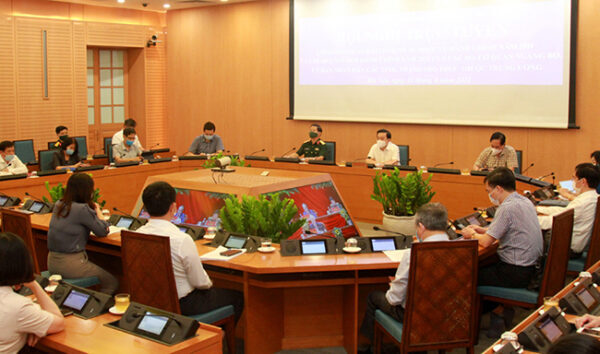
View of the Conference at the Hanoi city – Photo: Le Hai
On the afternoon of June 24, 2021, Mr. Truong Hoa Binh – Standing Deputy Prime Minister, Head of the Government Steering Committee for Administrative Reform, chaired an online conference to announce the Satisfaction Index of Public Administration Services (SIPAS) 2020 and Public Administration Reform Index (PAR INDEX) 2020 of ministries, ministerial-level agencies, People’s Committees of provinces and centrally-run cities.
Also attending the conference was Ms. Pham Thi Thanh Tra – Member of the Party Central Committee, Minister of Home Affairs, Standing Deputy Head of the Government Steering Committee for Administrative Reform. Attending in Hanoi city were Mr. Chu Xuan Dung – Vice Chairman of the City People’s Committee and representatives of several departments, divisions and branches of the City.
Speaking at the opening of the conference, Ms. Pham Thi Thanh Tra – Minister of Home Affairs said: 2020 is the 9th consecutive year of performing the tasks of the Government Steering Committee for Administrative Reform, the Ministry of Home Affairs in coordination with other agencies. Ministries, branches, localities and relevant agencies shall deploy, determine and publish the PAR Index of ministries and provinces; 2020 is the 4th year of measuring the Satisfaction Index of Public Administration Services in 63 provinces and cities across the country.
According to the report, the results of the PAR Index 2020 of ministries and ministerial-level agencies continue to focus on two groups of points. The first group, which achieved over 90%, continued to be 3 units: the State Bank of Vietnam, the Ministry of Finance, and the Ministry of Justice. The second group, which achieved the PAR Index results from over 80% to less than 90%, consists of 14 units.
The results of the PAR Index 2020 of provinces and cities are classified into 3 groups: Group A, with index results of 90% or more, including 2 provinces and cities (Quang Ninh, Hai Phong). Group B, with index results from 80% to less than 90%, includes 56 provinces and cities. Group C, with index results from 70% to less than 80%, includes 5 provinces and cities.
According to the assessment, the PAR Index 2020 of provinces and centrally-run cities has an average value of 83.72%, 2.57% higher than the average value in 2019 (81.15%) and reached the highest value in the last 5 years. Notably, in 2020 58 localities were achieving the PAR Index of over 80%, while in 2019 there were only 44 units and in 2018 there were only 9 units in this group; no locality achieved results below 70%.
Regarding the ranking of PAR Index 2020: Hanoi city ranks 8th with a result of 86.07%. Quang Ninh province continues to be ranked first in the rankings with the result reaching 91.04%; Hai Phong city with the result of 90.51%. Next are the provinces: Thua Thien Hue with 88.47%, Binh Duong 86.93%, Dong Thap 86.77%… Quang Ngai province ranked 63/63 provinces and cities with the result of 73.25%.
Speaking at the conference, on behalf of the Government and the Steering Committee for Administrative Reform (PAR), Mr. Truong Hoa Binh – Standing Deputy Prime Minister praised the efforts of the ministries, central branches and provinces, cities and especially the Ministry of Home Affairs in implementing and defining the SIPAS Index and the PAR Index 2020.
In the coming time, the Standing Deputy Prime Minister of the Government requested ministries, branches and localities based on the results of the SIPAS Index 2020 and the PAR Index 2020 to continue to take new, suitable and breakthrough measures and solutions to improve and raise the quality of public administrative service provision for people and organizations. Organize the implementation of the State PAR Program for the period 2021-2030 comprehensively, synchronously, with focus, depth, practicality and efficiency; taking the satisfaction of the people as a measure to evaluate the performance quality of the State administrative apparatus.
The Government’s Standing Deputy Prime Minister also requested ministries, branches and localities to continue promoting administrative procedure reform, review and propose to reduce and simplify regulations on business activities as prescribed in Resolution No. 68/NQ-CP of the Government. Renovate the implementation of the one-stop-shop mechanism in solving administrative procedures in the direction of improving service quality, increasing the application of information technology, reducing travel time, social costs, and creating favorable conditions for people and businesses according to Decision No. 468/QD-TTg of the Prime Minister.
Further improve the efficiency of online public service delivery on the National Public Service Portal, the public service portal of ministries, branches and localities. At the same time, continue to develop and perfect policies and laws on the organization of the State administrative apparatus. Promote the review and arrangement of the organizational apparatus and consolidate the functions and tasks of administrative agencies and public non-business units in accordance with the provisions of Resolution No. 18-NQ/TW, Resolution No. 19-NQ/TW of the Sixth Conference of the 12th Party Central Committee and guiding documents. Promote the application of information technology, digital transformation and the application of scientific and technological advances to complete the construction and development of e-government and digital government, contributing to improving productivity and efficiency of State administrative agencies at all levels; improve the quality of public service provision for people and organizations.
Continue to effectively implement the sending and receiving of electronic documents between different levels of government; meeting online and handling work in the electronic environment; complete the construction of an information and reporting system for ministries, branches and localities integrated with the Government reporting system; focus on prioritizing resources for the implementation of tasks in the Strategy for E-Government Development towards Digital Government in the period 2021-2025 with a vision to 2030.
Hai Le

